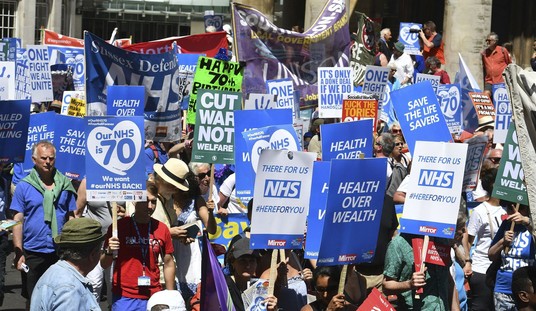The news today from the Department of Labor wasn’t terribly dramatic, in and of itself. Once again, weekly initial jobless claims dipped, but only because the previous week’s dip got adjusted upwards for the 4,786th week out of 4,787:
In the week ending June 16, the advance figure for seasonally adjusted initial claims was 387,000, a decrease of 2,000 from the previous week’s revised figure of 389,000. The 4-week moving average was 386,250, an increase of 3,500 from the previous week’s revised average of 382,750.
The advance seasonally adjusted insured unemployment rate was 2.6 percent for the week ending June 9, unchanged from the prior week’s unrevised rate.
The advance number for seasonally adjusted insured unemployment during the week ending June 9 was 3,299,000, unchanged from the preceding week’s revised level. The 4-week moving average was 3,293,750, an increase of 5,250 from the preceding week’s revised average of 3,288,500.
Reuters, however, notices something a bit more newsworthy — and since I pick on them over their reporting on this series, it’s only fair to give them credit for this (emphasis mine):
The number of Americans filing new claims for unemployment benefits was little changed last week, according to government data on Thursday that suggested the labor market was struggling to regain momentum.
Initial claims for state unemployment benefits slipped 2,000 to a seasonally adjusted 387,000, the Labor Department said. The prior week’s figure was revised up to 389,000 from the previously reported 386,000.
Economists polled by Reuters had forecast claims falling to 380,000 last week. The four-week moving average for new claims, considered a better measure of labor market trends, increased 3,500 to 386,250 — the highest level since early December.
Now, you may wonder how we got to the highest 4-week average of initial jobless claims for the year, when nearly every week the DoL reports a decline in the number of jobless claims from the week before. A lot of us are wondering the same thing about the initial estimates, which always have to get raised the next week. There is something amiss in the methodology, and it’s easy to assume it’s malicious, but in the end it doesn’t do much to help or hinder anyone. It’s the four-week average that most economists use anyway.
Clearly, using that measure, the coming jobs report for June is not going to improve much over May. The Fed also seems to think so, and they’re twisting the night (and day) away to try to wring a little more short-term growth out of the moribund economy:
Federal Reserve officials extended their efforts to boost the sluggish U.S. economy and said they were ready to do more if necessary to spur job growth.
They acted despite worries inside and outside the Fed that the central bank already has done all it can do to invigorate the disappointing economic recovery.
The Fed said Wednesday it would extend through the end of the year a program known as “Operation Twist,” which aims to drive down long-term interest rates and reduce borrowing costs for businesses and households. Under the program, the Fed sells short-term securities and uses the proceeds to buy longer-term securities.
Fed Chairman Ben Bernanke made clear in a news conference after the policy makers’ meeting that he is prepared to take further action if he doesn’t see progress on bringing down unemployment, which was 8.2% in May.
They won’t be the only ones twisting, either. If the June jobs report shows another sub-par or worse month, Obama’s “private sector is doing fine” and Tom Vilsack’s “the economy has turned the corner” remarks are going to get used as clubs against the administration all summer long. And at this point, not even Reuters can claim that such a result would be unexpected.








Join the conversation as a VIP Member